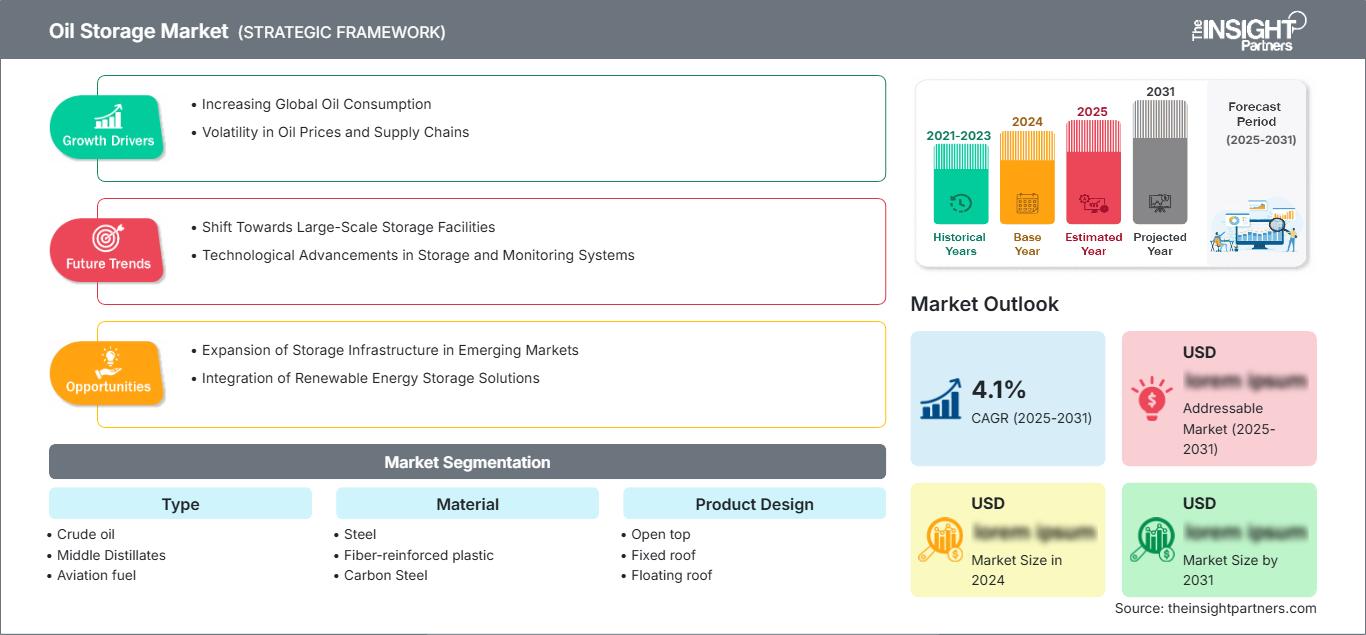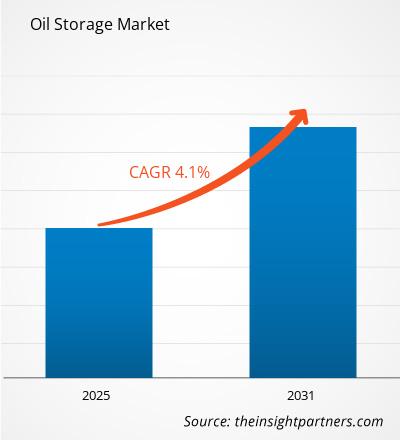页面已更新 :
Jan 2025
预计石油储存市场在 2025 年至 2031 年期间的复合年增长率为 4.1%,市场规模将从 2024 年的 XX 百万美元扩大到 2031 年的 XX 百万美元。
该报告按类型(原油、中间馏分油、航空燃料、其他)细分;材料(钢、纤维增强塑料 (FRP)、碳钢);产品设计(敞篷、固定顶、浮顶、其他)。全球分析进一步细分为区域和主要国家。该报告以美元提供上述分析和细分的价值。
报告目的
Insight Partners 撰写的《石油储存市场》报告旨在描述现状和未来增长、主要驱动因素、挑战和机遇。这将为各种商业利益相关者提供见解,例如:
- 技术提供商/制造商:了解不断变化的市场动态并了解潜在的增长机会,使他们能够做出明智的战略决策。
- 投资者:对市场增长率、市场财务预测和整个价值链中存在的机会进行全面的趋势分析。
- 监管机构:规范市场政策和警察活动,旨在最大限度地减少滥用,维护投资者的信任和信心,维护市场的完整性和稳定性。
石油储存市场细分类型
- 原油
- 中间馏分油
- 航空燃料
- 其他
材料
- 钢
- 纤维增强塑料
- 碳钢
产品设计
- 开放式顶部
- 固定式顶部
- 浮动式顶部
- 其他
地理分布
- 北美
- 欧洲
- 亚太地区
- 南美和中美
- 中东和非洲
自定义此报告以满足您的要求
您将免费获得任何报告的定制,包括本报告的部分内容,或国家级分析、Excel 数据包,以及为初创企业和大学提供超值优惠和折扣
石油仓储市场: 战略洞察

- 获取本报告的主要市场趋势。这个免费样本将包括数据分析,从市场趋势到估计和预测。
石油仓储市场增长动力
- 全球石油消费量增长:各行各业、交通运输和能源领域对石油的需求不断增长,是石油仓储市场的主要驱动力。尽管可再生能源不断发展,但石油仍然是许多国家的主要燃料。随着全球石油消费量的增加,对高效仓储解决方案(包括油罐和终端)的需求对于管理供应和确保石油供应不间断变得愈发重要,从而推动了石油仓储市场的增长。
- 油价和供应链的波动:油价波动和地缘政治事件往往会导致全球石油供应链不稳定。在价格波动或供应中断期间,石油公司和贸易商会增加仓储容量,以管理库存,利用有利的价格或对冲未来的供应短缺。这种市场动态鼓励战略性石油储存设施的建设,尤其是在关键位置,以确保公司能够在不确定的时期保持稳定的供应。
石油储存市场未来趋势
- 向大型储存设施转变:随着全球石油消费量的持续增长,建设更大、更高效的储存设施的趋势明显。更大的储罐可以储存更多的石油,提高物流效率并降低石油公司的运营成本。这些大型设施通常位于主要航运路线或炼油枢纽附近,以简化配送并增强供应链灵活性,满足市场需求和储存容量优化需求。
- 储存和监控系统的技术进步:监控系统和储罐设计的创新正在改变石油储存市场。使用先进的传感器、自动化控制和物联网 (IoT) 等数字技术可以实时监控储存条件,例如温度、压力和油品质量。这样可以确保更佳的库存管理、更高的安全性并防止溢出或泄漏,从而提高存储操作的整体效率和可持续性。
石油存储市场机遇
- 新兴市场存储基础设施的扩张:新兴经济体(尤其是亚太、中东和非洲等地区)的快速工业化和城市化正在推动对石油存储基础设施的需求激增。随着这些地区增加石油消费以支持经济增长,企业在投资建设新的存储设施方面面临着巨大的机会。这些市场提供了巨大的增长潜力,尤其是在炼油能力不断扩大、燃料消耗不断增长的国家。
- 可再生能源存储解决方案的整合:随着能源行业向更清洁、更多样化的燃料结构转型,将石油存储设施与可再生能源存储解决方案整合的机会越来越多。这包括利用多余的可再生能源为炼油厂供电,或整合将石油与生物燃料或其他可持续替代品相结合的混合存储解决方案。随着对低碳燃料的需求不断增长,石油储存基础设施可以不断发展,以适应更广泛的燃料,从而为运营商提供多样化的收入来源。
石油储存市场区域洞察
The Insight Partners 的分析师已详尽阐述了预测期内影响石油储存市场的区域趋势和因素。本节还讨论了北美、欧洲、亚太地区、中东和非洲以及南美和中美洲的石油储存市场细分和地理位置。
石油储存市场报告范围
| 报告属性 | 细节 |
|---|---|
| 市场规模 2024 | US$ XX million |
| 市场规模 2031 | US$ XX Million |
| 全球复合年增长率 (2025 - 2031) | 4.1% |
| 历史数据 | 2021-2023 |
| 预测期 | 2025-2031 |
| 涵盖的领域 |
By 类型
|
| 覆盖地区和国家 | 北美
|
| 市场领导者和主要公司简介 |
|
石油存储市场参与者密度:了解其对业务动态的影响
石油存储市场正在快速增长,这得益于终端用户需求的不断增长,而这些需求的驱动因素包括消费者偏好的转变、技术进步以及对产品优势的认知度的提升。随着需求的增长,企业正在扩展产品线,不断创新以满足消费者需求,并抓住新兴趋势,从而进一步推动市场增长。

- 获取 石油仓储市场 主要参与者概述
主要卖点
- 全面覆盖:该报告全面涵盖了对石油储存市场的产品、服务、类型和最终用户的分析,提供了整体格局。
- 专家分析:该报告基于对行业专家和分析师的深入了解而编写。
- 最新信息:由于该报告涵盖了最新信息和数据趋势,因此确保了业务相关性。
- 定制选项:此报告可以根据特定客户要求进行定制,并恰如其分地适应业务策略。
因此,有关石油储存市场的研究报告可以帮助引领解码和理解行业情景和增长前景的线索。尽管可能存在一些合理的担忧,但本报告的总体优势往往大于劣势。
- 历史分析(2 年)、基准年、预测(7 年)及复合年增长率
- PEST和SWOT分析
- 市场规模、价值/数量 - 全球、区域、国家
- 行业和竞争格局
- Excel 数据集
近期报告
相关报告
客户评价
购买理由
- 明智的决策
- 了解市场动态
- 竞争分析
- 客户洞察
- 市场预测
- 风险规避
- 战略规划
- 投资论证
- 识别新兴市场
- 优化营销策略
- 提升运营效率
- 顺应监管趋势
我们的客户































87-673-9708

ISO 9001:2015



 获取免费样品 - 石油仓储市场
获取免费样品 - 石油仓储市场